In a lot of ways, piazzas have always been the heart and soul of Italian cities. Not only are these large public squares usually surrounded by many of the cities’ grand architectural wonders and are a focal point for cultural activities, they are also popular spaces where locals and tourists alike take a breather from all the urban hustle and bustle.
Granted, many of these piazzas have been silent witnesses to darker periods in history, but nowadays, they mainly serve as majestic temples to la dolce vita, a place where everyone can play, unwind, spend time with loved ones, shop, dine, be entertained, enjoy coffee, take in the surroundings, or simply contemplate things in the solitude of one’s own thoughts.
In this article, we list the 10 most famous piazzas in Italy. Find out what makes each one of them special, and if you haven’t already, maybe someday, you’ll find yourself visiting one, some, or all of them! Here they are, in no particular order:
Piazza San Pietro, Rome
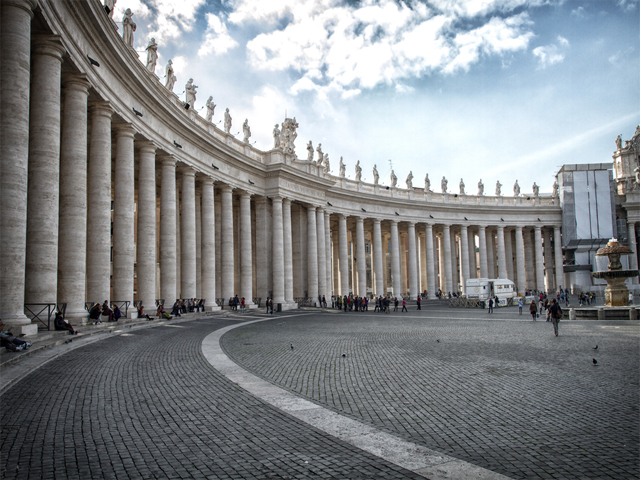
Originally, only the four-thousand-year-old Egyptian obelisk erected in 1568 and a Carlo Maderno fountain built in 1613 were the prominent features of the open space in front of St. Peter’s Basilica. Between the years 1656 to 1667, however, Pope Alexander VII commissioned architect Gian Lorenzo Bernini to redesign the space and turn it into the modern piazza we know at present. Today, gigantic Doric-style colonnades surround the square, achieving Bernini’s purpose of creating a space meant to make visitors feel they are being welcomed into the open arms of Christendom.
Piazza San Marco, Venice
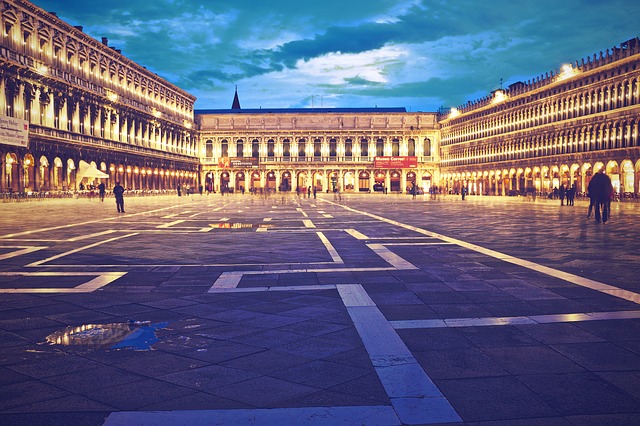
Napoleon is said to have called St. Mark’s Square “the finest drawing room in Europe?” Finest perhaps, in a lot of different ways, but to compare something so grand to something so common as a room? How contemptible!
The piazza’s more-than-1,200-year-old history alone makes it one of the most culturally and historically significant sites in Italy. Furthermore, the landmarks surrounding it — the 900-year-old Italo-Byzantine St. Mark’s Basilica and its prominent campanile (bell tower), the Grand Canal, the Palazzo Ducale, plus the entire ancient city of Venice itself and its famous lagoon makes visiting Piazza San Marco all the more special.
Piazza dei Miracoli, Pisa
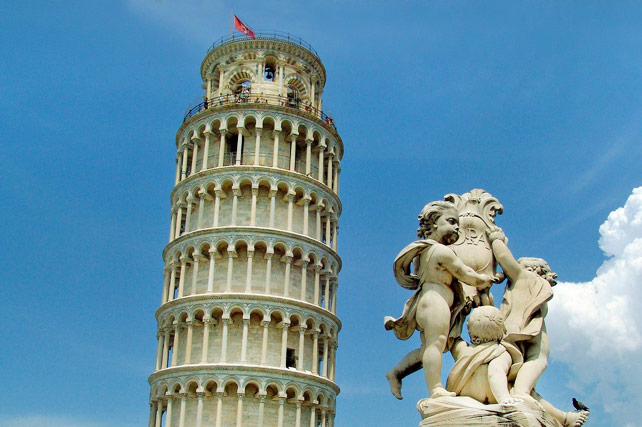
Formally known as the Piazza del Duomo (cathedral square) of Pisa, the Piazza dei Miracoli is one of the most recognizable public squares in Italy, thanks in no small part to the world-famous monuments built within its premises. The walled complex is home to the Pisa Baptistry, the Camposanto Monumentale (Monumental Cemetery), and of course, the Pisa Cathedral and its distinctive campanile, which is more popularly known as the Leaning Tower of Pisa.
The piazza, whose construction began in the 11th century, is considered as one of the most outstanding Medieval public squares in Europe. In 1987, the entire piazza and its buildings were inscribed into the UNESCO World Heritage list.
Piazza del Campo, Siena
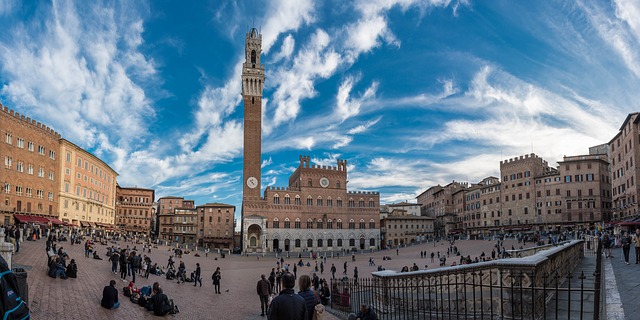
The Piazza del Campo stands on the meeting point of three hillside settlements which came together to form the town of Siena. The square is adjacent to the Palazzo Pubblico (town hall), which was first built in 1297, and to the Torre del Mangia, a bell tower which, at 289 feet, became one of the tallest Medieval towers in Italy when it was completed in 1348.
Before the 13th century, the site where the Piazza del Campo now stands was a simple open marketplace. In 1349, it was paved with red brick to form a shell-shaped public space with nine divisions that fan out from a central water drain known as gavinone. Today, it still is an important part of Sienese culture, serving host to the Palio di Siena, a traditional horse race which started in 1656.
Piazza della Cisterna, San Gimignano
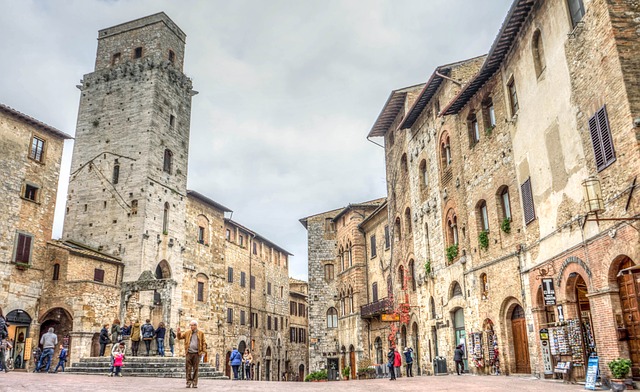
For all the skyscrapers that surrounded Piazza della Cisterna at the height of San Gimignano’s tower-building bonanza during the 12th century, one could probably consider it as the Times Square of Medieval Europe.
In fact, toward the end of the Medieval period, a total of 72 towers were built in the city, some of which reached the height of 230 feet (70 meters). Although only 14 of these towers remain today, they still look impressive, and there’s no better way to appreciate them than in Piazza della Cisterna, which is encircled by five of them, namely Torre dei Becci, Torre dei Cugnanesi, Torre del Diavolo, Torri degli Ardinghelli, and Torre di Palazzo Pellari.
The origin of the piazza’s name is preserved through the octagon-shaped pedestal at the center of the square. The platform, built in 1346, is the cap of an underground cistern that was built half a century earlier to store water for the city.
Piazza del Duomo of Florence
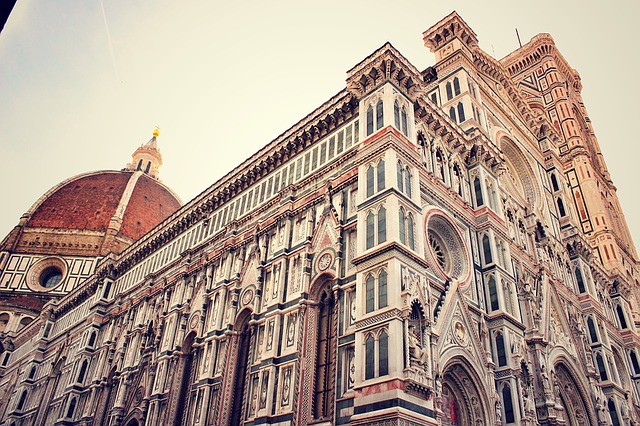
At the very heart of Florence’s historic center lies the Piazza del Duomo and its exceptional collection of works of art and architecture. One of the architectural jewels that surround the square is the magnificent Basilica di Santa Maria del Fiore (Basilica of Saint Mary of the Flower), whose Gothic exterior was designed by Arnolfo di Cambio and whose famous dome was engineered by Filippo Brunelleschi. Standing near this cathedral is its 278-foot Florentine Gothic campanile designed by Giotto, which was first built in 1334. Across the church also stands the Battistero di San Giovanni (Baptistry of St. John), which was constructed between 1059 and 1128.
The piazza is part of the city’s historic center, which was declared a UNESCO World Heritage Site in 1982. Today it is one of the most visited places both in Europe and in the whole world.
Piazza del Duomo of Milan
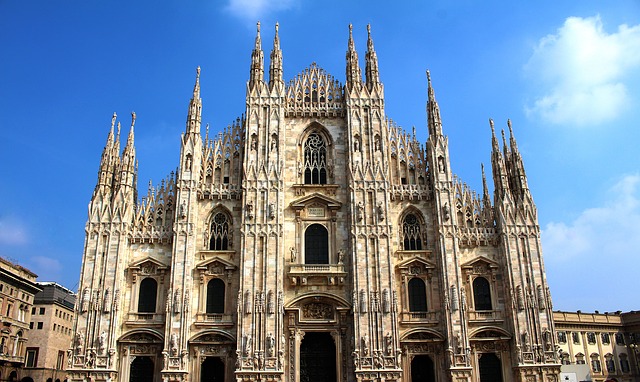
Another cathedral square that is equally renowned the world over is the Piazza del Duomo of the city of Milan. It is known mainly for being home to the Milan Cathedral, the fifth largest cathedral in the world. The Gothic-style church took almost six centuries to build, with the first stone laid in 1386 and the last gate inaugurated only in 1965. Other important buildings found around the piazza include the Palazzo Reale di Milano (the royal palace), which is now an important cultural center, and the Galleria Vittorio Emanuele, which was completed in 1877 and is today one of the oldest shopping malls in the world.
Although the piazza’s current look largely dates back to 1860, the open space itself has been around since 1330, when the lord of Milan, Azzone Visconti, ordered the creation of a market square which first became known as the Piazza dell’Arengo. The square was redesigned several times over the centuries. In 1860, the city government launched a competition for the redesigning of the piazza in celebration of the unification of Italy into a single kingdom — a contest won by architect Giuseppe Mengoni.
Piazza del Popolo, Ascoli Piceno
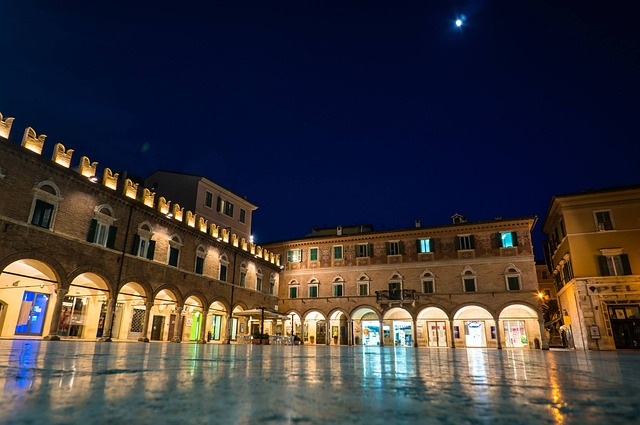
Visitors of this beautiful Renaissance courtyard can confirm that there are few piazzas in Italy that are as enthralling as the Piazza del Popolo in the town of Ascoli Piceno.
Much of the square’s present design can be traced back to the 16th century, when, after a long period of neglect, renovations were carried out in order for the piazza to reflect harmony, symmetry, and elegance – values that were important in the Renaissance school of thought.
The piazza is paved in travertine limestone, and the surrounding buildings feature elegant porticos, arches, and colonnades. Bordering the piazza are the Palazzo dei Capitani, previously the headquarters of the influential Capitani order, and Saint Francis’ Church, a Romanesque structure that was built in a period of almost two centuries.
In addition to its design, the Piazza del Popolo is also known for staging the Quintana, an annual Renaissance tournament and jousting event held in August every year.
Piazza Navona, Rome
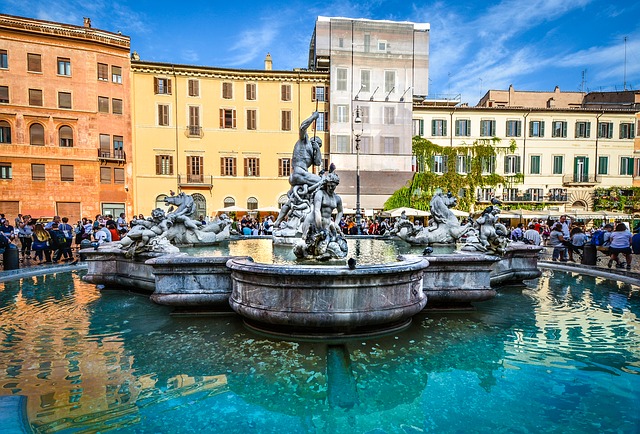
The truth is, there are just so many piazzas in Rome that it is hard not to include another one on this list. Not when they are the likes of Piazza Navona, which is arguably the most beautiful city square in Rome and one of the most important in terms of history and heritage. The piazza is known for its beautiful architectural treasures designed in the Baroque Roman tradition. These include the Palazzo Pamphilj and the Church of Sant’Agnese in Agone, both of which were built in the 17th century. It is also home to the famous Fontana dei Quattro Fiumi or Fountain of Four Rivers. Built in 1651, it represents four rivers in four continents, namely Africa’s Nile River, Europe’s Danube, Asia’s River Ganges, and the Americas’ Río de la Plata.
The present site of the piazza sits over the interior arena of the ancient Stadium of Domitian, commissioned in 80 BCE by Emperor Domitian for the staging of agones or games. This is why the piazza still follows the stadium’s shape, while the stadium’s original lower arcades are actually integrated into parts of the buildings that now surround the square.
Piazza Maggiore, Bologna

Like most piazzas in Italy, the Piazza Maggiore in Bologna started out as a simple marketplace where people gathered and important town events were held. During the Medieval period, the city government envisioned a more organized town square where important buildings will be clustered. Thus, the construction of the new piazza began in the 13th century.
The present square is bordered by Gothic and Renaissance-style buildings. The oldest of these is the Palazzo del Podestà, which was finished in the year 1200 and once served home to the podestà or the local public officials of the commune. Other structures include the Palazzo d’Accursio (constructed in the 13th century), Palazzo dei Notai (first built in 1381), the Palazzo dei Banchi (first built in 1412), and the Basilica of San Petronio, an unfinished church which stands today as the 15th largest in the world.
Yes, this list does not include other popular squares like Rome’s Piazza di Trevi (home of the Trevi Fountain), or Florence’s Piazza della Signora. Others might even argue that these piazzas are more popular than some mentioned on this list. It is therefore a good thing, perhaps, that travel lists can only try to be as comprehensive as they could. That way, travelers can decide whether or not they should go and see more places other than those already suggested. Which ones will you include in your itinerary?



















